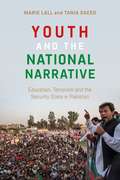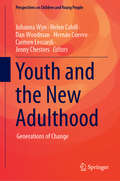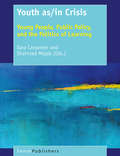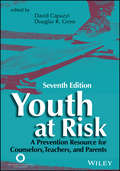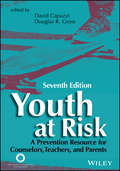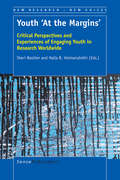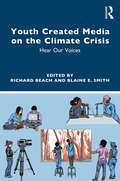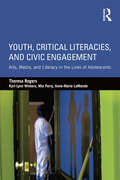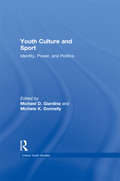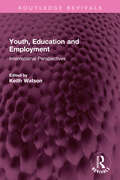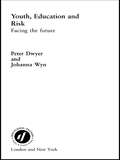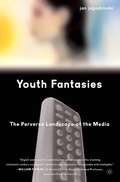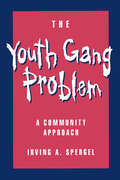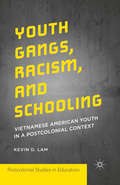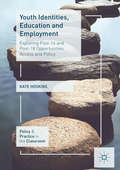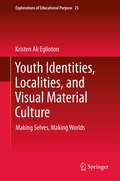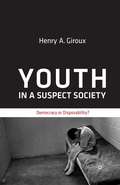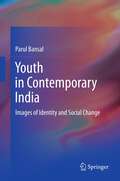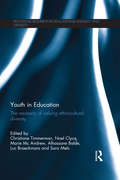- Table View
- List View
Youth and the National Narrative: Education, Terrorism and the Security State in Pakistan
by Marie Lall Tania SaeedThe role of the security establishment in Pakistan has been strengthened in a post-Musharraf era as social institutions are increasingly drawn into the security agenda. Pakistan's problems are often explained through the lens of ethnic or religious differences, the tense relationship between democracy and the Pakistan military, or geopolitics and terrorism, without taking into account young citizens' role in questioning the state and the role of the education system. Based on new research and interviews with more than 1900 Pakistanis aged 16-28 the authors examine young people's understanding of citizenship, political participation, the state and terrorism in post-Musharraf Pakistan. The authors explore the relationship between the youth and the security state, highlighting how the educational institutions, social media, political activism and the entire nature of the social contract in Pakistan has been increasingly securitized. The focus is on the voices of young Pakistanis, their views on state accountability (or lack thereof), political literacy and participation, and the continued problem of terrorism that is transforming their views of both their country and the world today. With 67% of the country's population under the age of 30, this book is a unique window into how Pakistan is likely to evolve in the next couple of decades.
Youth and the New Adulthood: Generations of Change (Perspectives on Children and Young People #8)
by Johanna Wyn Helen Cahill Dan Woodman Hernán Cuervo Carmen Leccardi Jenny ChestersThis book investigates the life trajectories of Generation X and Y Australians through the 1990s and 2000s. The book defies popular characterizations of members of the ‘precarious generations’ as greedy, narcissistic and self-obsessed, revealing instead that many of the members of these generations struggle to reach the standard of living enjoyed by their parents, value learning highly and are increasingly concerned about the environment and the legacy current generations are leaving for their children and remain optimistic in the face of considerable challenges. Drawing on data from the Life Patterns longitudinal study of Australian youth (an internationally recognized study), the book tells the story of members of these ‘precarious generations’. It examines significant dimensions of young people’s lives across time, comparing how domains such as health and well-being, education, work and relationships intersect to produce the complex outcomes that characterize the lives of members of each of these generations. It also explores the strategies these generations use to make their lives and the ways in which they remain resilient. While the book is based on Australian data, the analysis draws on and contributes to the international literature on young people and social change.
Youth as/in Crisis: Young People, Public Policy, and the Politics of Learning
by Sara Carpenter Shahrzad MojabInternationally, there is a growing argument amongst policy makers and academics that broadening spectrums of young adults are ‘at-risk’ of various types of material, social, physical, and cultural insecurity. In this way, the traditional identification of transitions from youth to adulthood, marked by points of permanence such as stable employment, are beginning to fray. Through various academic, popular, and policy literatures, young people today are imagined as being both ‘threatened’ by social inequality as well as a ‘threat’ against which our notions of security and social cohesion are constructed. This edited collection includes empirical and theoretical work concerning the relationships between youth/young adults, public policy, and educational research, with its primary focus being new forms of public policy in Canada that, we argue, are emblematic of international policy instruments examining the policy and economic participation of young people. Examining key sites of youth participation, including post-secondary institutions, community-based programs, and work/employment programs, the included case studies examine how young people navigate and learn from everyday experiences of marginalization and violence while at the same time illuminating how these experiences are organized and reproduced through the very institutions that are meant to shape young people’s engagement in society.
Youth at Risk: A Prevention Resource for Counselors, Teachers, and Parents
by David Capuzzi Douglas R. GrossThis comprehensive text, written by experts in each topical area, provides research-based approaches designed for work with youth in the difficult transition from adolescence to adulthood. Developmental in its orientation, the text moves from population definition and identification, to causal factors and issues most often identified with placing youth at risk, to a prevention–intervention paradigm specifically created for teens. Illustrative case studies and enlightening sidebars enhance reader self-awareness, promote self-study and skill development, and aid in the comprehension of the concepts and applications of chapter material. Complimentary PowerPoint slides, test banks, and instructional activities are available for instructors’ use by request to ACA. *Requests for digital versions from the ACA can be found on wiley.com. *To request print copies, please visit the ACA website here. *Reproduction requests for material from books published by ACA should be directed to permissions@counseling.org
Youth at Risk: A Prevention Resource for Counselors, Teachers, and Parents
by David Capuzzi Douglas R. GrossThis comprehensive text, written by experts in each topical area, provides research-based approaches designed for work with youth in the difficult transition from adolescence to adulthood. Developmental in its orientation, the text moves from population definition and identification, to causal factors and issues most often identified with placing youth at risk, to a prevention–intervention paradigm specifically created for teens. Illustrative case studies and enlightening sidebars enhance reader self-awareness, promote self-study and skill development, and aid in the comprehension of the concepts and applications of chapter material. Complimentary PowerPoint slides, test banks, and instructional activities are available for instructors’ use by request to ACA. *Requests for digital versions from the ACA can be found on wiley.com. *To request print copies, please visit the ACA website here. *Reproduction requests for material from books published by ACA should be directed to permissions@counseling.org
Youth ‘At the Margins’: Critical Perspectives and Experiences of Engaging Youth in Research Worldwide (New Research – New Voices #0)
by Sheri Bastien Halla B. HolmarsdottirThis volume comes at a critical juncture, as global commitments transition from the Millennium Development Goals to Sustainable Development Goals and the wider post-2015 development agenda is being discussed and debated. In these discussions, children and youth have been recognized as one of the nine major groups of civil society whose participation in decision making is essential for achieving sustainable development. There is also a concomitant need for action – innovative, evidence-based approaches to addressing entrenched global challenges or ‘wicked problems’ and engaging youth in those efforts. Within academic discourse, the perspectives and active participation of youth in research has long been debated. It is widely believed that their participation can result in better policy responses and contribute to the development of more relevant and effective interventions and programs to address their needs. However, the engagement of youth in research processes is not without critique; issues such as how to move from tokenism towards authentic participation and empowerment have been critically discussed, and many question if youth can or should even be expected to make change happen. Youth ‘At the Margins’: Critical Perspectives and Experiences of Engaging Youth in Research Worldwide brings together a range of critical and empirical contributions from emerging scholars and seasoned academics alike. Each contribution provides a unique perspective on the potentialities and challenges associated with youth engaged research. The chapters presented in this volume strive to critically interrogate and debate important foundational issues to consider when engaging youth in the research process, such as epistemological and methodological considerations. Important insights into the ethical, pedagogical and practical aspects one must contend with can be gleaned from the selection of chapters here; some of which are primarily theoretical and descriptive, whilst others present empirical data with case examples from around the world. This volume is devoted to showcasing high quality contributions to the scholarly literature on youth engaged research in order to spur further critical debate on the various epistemological, methodological and ethical issues associated with engaging youth in research processes and in addressing intractable global issues. The audience for this volume includes students, researchers and academics within a broad range of fields who are interested in understanding the range of approaches being used worldwide to include youth in research endeavors on issues of global importance including poverty, social exclusion, structural violence, un- and under-employment, education and health.
Youth Created Media on the Climate Crisis: Hear Our Voices
by Richard Beach Blaine E. SmithThis timely book provides effective methods and authentic examples of teaching about climate change through digital and multimodal media production in the English Language Arts classroom. The chapters in this edited volume demonstrate the benefits of addressing climate change in the classroom through innovative media production and cover a range of different types of media, including video/digital storytelling, social media, art, music, and writing, with rich resources for instruction in every chapter. Through the engaging ideas and strategies, the contributors equip educators with the critical tools for supporting students’ media production. In so doing, they offer new perspectives on how students can employ media and production techniques to critique the status quo, call for change, and acquire new literacy skills. As the effects of the climate crisis become increasingly visible to the youth population, this book helps foster and support youth agency and activism. Youth Media Creation on the Climate Change Crisis: Hear Our Voices is a necessary text for students, preservice teachers, and educators in literacy education, media studies, social and environmental studies, and STEM education. The eBook+ version of the text features embedded audio and video components as well as interactive links to reflect the multimodal nature of students’ work, spotlighting how youth media production supports the development of students’ critical literacy skills and shapes their voices and identities.
Youth Created Media on the Climate Crisis: Hear Our Voices
This timely book provides effective methods and authentic examples of teaching about climate change through digital and multimodal media production in the English Language Arts classroom. The chapters in this edited volume demonstrate the benefits of addressing climate change in the classroom through innovative media production and cover a range of different types of media, including video/digital storytelling, social media, art, music, and writing, with rich resources for instruction in every chapter. Through the engaging ideas and strategies, the contributors equip educators with the critical tools for supporting students’ media production. In so doing, they offer new perspectives on how students can employ media and production techniques to critique the status quo, call for change, and acquire new literacy skills. As the effects of the climate crisis become increasingly visible to the youth population, this book helps foster and support youth agency and activism. Youth Media Creation on the Climate Change Crisis: Hear Our Voices is a necessary text for students, preservice teachers, and educators in literacy education, media studies, social and environmental studies, and STEM education. The eBook+ version of the text features embedded audio and video components as well as interactive links to reflect the multimodal nature of students’ work, spotlighting how youth media production supports the development of students’ critical literacy skills and shapes their voices and identities.
Youth, Critical Literacies, and Civic Engagement: Arts, Media, and Literacy in the Lives of Adolescents
by Theresa Rogers Kari-Lynn Winters Mia Perry Anne-Marie LaMondeThrough stories of youth using their many voices in and out of school to explore and express their ideas about the world, this book brings to the forefront the reality of lived literacy experiences of adolescents in today’s culture in which literacy practices reflect important cultural messages about the interplay of local and global civic engagement. The focus is on three areas of youth civic engagement and cultural critique: homelessness, violence, and performing adolescence. The authors explore how youth appropriate the arts, media, and literacy as resources and how this enables them to express their identities and engage in social and cultural engagement and critique. The book describes how the youth in the various projects represented entered the public sphere; the claims they made; the ways readers might think about pedagogical engagements, practice, and goals as forms of civic engagement; and implications for critical and arts and media-based literacy pedagogies in schools that forward democratic citizenship in a time when we are losing sight of issues of equity and social justice in our communities and nations.
Youth, Critical Literacies, and Civic Engagement: Arts, Media, and Literacy in the Lives of Adolescents
by Theresa Rogers Kari-Lynn Winters Mia Perry Anne-Marie LaMondeThrough stories of youth using their many voices in and out of school to explore and express their ideas about the world, this book brings to the forefront the reality of lived literacy experiences of adolescents in today’s culture in which literacy practices reflect important cultural messages about the interplay of local and global civic engagement. The focus is on three areas of youth civic engagement and cultural critique: homelessness, violence, and performing adolescence. The authors explore how youth appropriate the arts, media, and literacy as resources and how this enables them to express their identities and engage in social and cultural engagement and critique. The book describes how the youth in the various projects represented entered the public sphere; the claims they made; the ways readers might think about pedagogical engagements, practice, and goals as forms of civic engagement; and implications for critical and arts and media-based literacy pedagogies in schools that forward democratic citizenship in a time when we are losing sight of issues of equity and social justice in our communities and nations.
Youth Culture and Sport: Identity, Power, and Politics (Critical Youth Studies)
by Michael D. Giardina Michele K. DonnellyYouth Culture and Sport critically interrogates and challenges contemporary articulations of race, class, gender, and sexual relations circulating throughout popular iterations of youth sporting culture in late-capitalism. Written against the backdrop of important changes in social, cultural, political, and economic dynamics taking place in corporate culture’s war on kids, this exciting new volume marks the first anthology to critically examine the intersection of youth culture and sport in an age of global uncertainty. Bringing together leading scholars from cultural studies, gender studies, sociology, sport studies, and related fields, chapters range in scope from 'action' sport subcultures and community redevelopment programs to the cultural politics of white masculinity and Nike advertising. It is a must read for anyone interested in gaining a better understanding of the role sport plays in the construction of experiences, identities, practices, and social differences of contemporary youth culture.
Youth Culture and Sport: Identity, Power, and Politics (Critical Youth Studies)
by Michael D. Giardina Michele K. DonnellyYouth Culture and Sport critically interrogates and challenges contemporary articulations of race, class, gender, and sexual relations circulating throughout popular iterations of youth sporting culture in late-capitalism. Written against the backdrop of important changes in social, cultural, political, and economic dynamics taking place in corporate culture’s war on kids, this exciting new volume marks the first anthology to critically examine the intersection of youth culture and sport in an age of global uncertainty. Bringing together leading scholars from cultural studies, gender studies, sociology, sport studies, and related fields, chapters range in scope from 'action' sport subcultures and community redevelopment programs to the cultural politics of white masculinity and Nike advertising. It is a must read for anyone interested in gaining a better understanding of the role sport plays in the construction of experiences, identities, practices, and social differences of contemporary youth culture.
Youth Cultures in a Globalized World: Developments, Analyses and Perspectives
by Hannes Krall Gerald KnappThis book examines the relation between the phenomenon of globalization, changes in the lifeworld of young people and the development of specific youth cultures. It explores the social, political, economic and cultural impact of globalization on young people. Growing diversity in their lifeworlds, technological development, migration and the ubiquity of digital communication and representation of the world open up new forms of self-representation, networking and political expression, which are described and discussed in the book. Other topics are the impact of globalization on work and economy, global environmental issues such as climate change, political movements which put “nationalism first”, change of youth`s values and the significance of body, gender and beauty. The book highlights the challenges of young people in modern life, as well as the way in which they express themselves and engage in society – in culture, politics, work and social life.
Youth, Education and Employment: International Perspectives (Routledge Revivals)
by Keith WatsonFirst published in 1983, Youth, Education and Employment tries to highlight the scale of the problem of youth unemployment in industrial societies by examining it from a variety of angles, and by drawing upon developments in other countries including those of the developing world. Examples are taken from France, Germany, Denmark and Sweden as well as from the United Kingdom, and also from Cuba and small island communities. This important volume shows the underlying causes of youth unemployment and offers positive solutions in particular stressing the need for a reappraisal of many educational practices. This book is a must read for educationists, policy makers and students of public policy.
Youth, Education and Employment: International Perspectives (Routledge Revivals)
by Keith WatsonFirst published in 1983, Youth, Education and Employment tries to highlight the scale of the problem of youth unemployment in industrial societies by examining it from a variety of angles, and by drawing upon developments in other countries including those of the developing world. Examples are taken from France, Germany, Denmark and Sweden as well as from the United Kingdom, and also from Cuba and small island communities. This important volume shows the underlying causes of youth unemployment and offers positive solutions in particular stressing the need for a reappraisal of many educational practices. This book is a must read for educationists, policy makers and students of public policy.
Youth, Education and Risk: Facing the Future
by Peter Dwyer Johanna WynYouth, Education and Risk: Facing the Future provides a provocative and valuable insight into how the dramatic social and economic changes of the last twenty years have affected the lives of Western youth. Covering young people's attitudes towards relationships and health, the authors provide a comprehensive perspective on young people in Western society in the 1990s.The book reviews ten years of research, policy and practice as related to the 15-25 age group and compares data from the UK, Australia, the USA and Canada. It also argues for the need to develop new research and policy frameworks that are more in tune with the changed conditions of life for Western youth. The book sets out the conceptual basis for a new approach to youth and the practical implications for research, education and youth policy in the new millenium.
Youth, Education and Risk: Facing the Future
by Peter Dwyer Johanna WynYouth, Education and Risk: Facing the Future provides a provocative and valuable insight into how the dramatic social and economic changes of the last twenty years have affected the lives of Western youth. Covering young people's attitudes towards relationships and health, the authors provide a comprehensive perspective on young people in Western society in the 1990s.The book reviews ten years of research, policy and practice as related to the 15-25 age group and compares data from the UK, Australia, the USA and Canada. It also argues for the need to develop new research and policy frameworks that are more in tune with the changed conditions of life for Western youth. The book sets out the conceptual basis for a new approach to youth and the practical implications for research, education and youth policy in the new millenium.
Youth Fantasies: The Perverse Landscape of the Media
by Jan JagodzinskiYouth Fantasies is a collection of studies conducted in cross-cultural collaboration over the past ten years that theorizes 'youth fantasy'; as manifested through the media of TV, film, and computer games. Unlike other media studies and education books, the authors employ both Lacanian and Kleinian psychoanalytic concepts to attempt to make sense of teen culture and the influence of mass media. The collection includes case studies of X-Files fans, the influence of computer games and the 'Lara Croft' phenomenon, and the reception of Western television by Tanzanian youth. The authors see this book as a much needed reconciliation between cultural studies and Lacanian psychoanalysis, and attempt to highlight why Lacan is important to note when exploring youth fantasy and interest in the media, especially in shows like X-Files .
The Youth Gang Problem: A Community Approach
by Irving A. SpergelEvery day there are new stories of gang-related crime: from the proliferation of illegal weapons in the streets and children dealing drugs in their schools, to innocent bystanders caught in the crossfire of never-ending gang wars. Once considered an urban phenomenon, gang violence is permeating American life, spreading to the suburbs and bringing the problem closer to home for much of America. The government, schools, social agencies, and the justice system are conspicuous by their sporadic interest in the subject and have failed to develop effective policies and programs. Existing social support mechanisms and strategies for suppressing violence have often been unsuccessful. And, state and federal policy is largely nonexistent. In The Youth Gang Problem: A Community Approach, Irving Spergel provides a systematic analysis of youth gangs in the United States. Based on research, historical and comparative analysis, and agency documents and the author's extensive first-hand experience, the work explores the gang problem from the perspective of community disorganization, especially population movement, and the plight of the underclass. It examines the factors of gang member personality, gang dynamics, criminal organization, and the influence of family, school, prisons, and politics, as well as the response of criminal justice agencies and community groups. Spergel describes techniques used by social agencies, schools, employment programs, criminal justice agencies, and grass-roots organizations for dealing with gangs, and recommends strategies that emphasize the use of local resources, planning, and collaborative procedures. There is no single strategy and no easy solution to the youth gang problem in the United States. There are, however, substantial steps we can take, and they must be honestly and systematically tested. Offering a practical and alternative approach to a serious social problem, The Youth Gang Problem: A Community Approach is a major and long-awaited contribution to this dilemma. It is required reading for criminal justice personnel, school staff, social workers, policy makers, students and scholars of urban and organizational sociology, and the general reader concerned with the youth gang problem and how to control, intervene, and prevent it.
Youth Gangs, Racism, and Schooling: Vietnamese American Youth in a Postcolonial Context (Postcolonial Studies in Education)
by Kevin D. LamWinner of the American Educational Studies Association 2016 Critics' Choice Book AwardYouth Gangs, Racism, and Schooling examines the formation of Vietnamese American youth gangs in Southern California. Lam addresses the particularities of racism, violence, and schooling in an era of anti-youth legislation and frames gang members as post-colonial subjects, offering an alternative analysis toward humanization and decolonization.
Youth Identities, Education and Employment: Exploring Post-16 and Post-18 Opportunities, Access and Policy (Policy and Practice in the Classroom)
by Kate HoskinsThis book investigates how policy, family background, social class, gender and ethnicity influence young people’s post-16 and post-18 employment and education access. It draws on existing literature, alongside new data gathered from a case study in a UK state secondary school, to examine how policy changes to the financial arrangements for further and higher education and the changing youth employment landscape have had an impact on young people’s choices and pathways. Hoskins explores a number of topics, including the role of identity in young people’s decision-making; the impact of changes to young people’s financial arrangements, such as cuts to the Education Maintenance Allowance and increased university fees; and the influence of support from parents and teachers. The book will be of interest to students and researchers of Education and Sociology.
Youth Identities, Localities, and Visual Material Culture: Making Selves, Making Worlds (Explorations of Educational Purpose #25)
by Kristen Ali EglintonThis invaluable addition to Springer’s Explorations of Educational Purpose series is a revelatory ethnographic account of the visual material culture of contemporary youths in North America. The author’s detailed study follows apparently dissimilar groups (black and Latino/a in a New York City after-school club, and white and Indigenous in a small Canadian community) as they inflect their nascent identities with a sophisticated sense of visual material culture in today’s globalized world. It provides detailed proof of how much ethnography can add to what we know about young people’s development, in addition to its potential as a model to explore new and significant avenues in pedagogy. Supported by a wealth of ethnographic evidence, the analysis tracks its subjects’ responses to strikingly diverse material ranging from autobiographical accounts by rap artists to the built environment. It shows how young people from the world’s cultural epicenter, just like their counterparts in the sub-Arctic, construct racial, geographic and gender identities in ways that are subtly responsive to what they see around them, blending localized characteristics with more widely shared visual references that are now universally accessible through the Web. The work makes a persuasive case that youthful engagement with visual material culture is a relational and productive activity that is simultaneously local and global, at once constrained and enhanced by geography, and possesses a potent and life-affirming authenticity. Densely interwoven with young people’s perspectives, the author’s account sets out an innovative and interdisciplinary conceptual framework affording fresh insights into how today’s youth assimilate what they perceive to be significant.Supported by a wealth of ethnographic evidence, the analysis tracks its subjects’ responses to strikingly diverse material ranging from autobiographical accounts by rap artists to the built environment. It shows how young people from the world’s cultural epicenter, just like their counterparts in the sub-Arctic, construct racial, geographic and gender identities in ways that are subtly responsive to what they see around them, blending localized characteristics with more widely shared visual references that are now universally accessible through the Web. The work makes a persuasive case that youthful engagement with visual material culture is a relational and productive activity that is simultaneously local and global, at once constrained and enhanced by geography, and possesses a potent and life-affirming authenticity. Densely interwoven with young people’s perspectives, the author’s account sets out an innovative and interdisciplinary conceptual framework affording fresh insights into how today’s youth assimilate what they perceive to be significant.Supported by a wealth of ethnographic evidence, the analysis tracks its subjects’ responses to strikingly diverse material ranging from autobiographical accounts by rap artists to the built environment. It shows how young people from the world’s cultural epicenter, just like their counterparts in the sub-Arctic, construct racial, geographic and gender identities in ways that are subtly responsive to what they see around them, blending localized characteristics with more widely shared visual references that are now universally accessible through the Web. The work makes a persuasive case that youthful engagement with visual material culture is a relational and productive activity that is simultaneously local and global, at once constrained and enhanced by geography, and possesses a potent and life-affirming authenticity. Densely interwoven with young people’s perspectives, the author’s account sets out an innovative and interdisciplinary conceptual framework affording fresh insights into how today’s youth assimilate what they perceive to be significant.
Youth in a Suspect Society: Democracy or Disposability?
by H. GirouxThrough the lens of education, this book attempts to situate young people within a number of theoretical and political considerations that offer up a new 'analytic of youth', one that posits not only the emergence of a new way to talk about youth but also a new language for understanding the politics that increasing frame their lives.
Youth in Contemporary India: Images of Identity and Social Change
by Parul BansalThis book endeavors to be a study of identity in Indian urban youth. It is concerned with understanding the psychological themes of conformity, rebellion, individuation, relatedness, initiative and ideological values which pervade youths’ search for identity within the Indian cultural milieu, specifically the Indian family. In its essence, the book attempts to explore how in contemporary India the emerging sense of individuality in youth is seeking its own balance of relationality with parental figures and cohesion with social order. The research questions are addressed to two groups of young men and women in the age group of 20-29 years-Youth in Corporate sector and Youth in Non Profit sector. Methodologically, the study is a psychoanalytically informed, process oriented, context sensitive work that proceeds via narrations, conversations and in-depth life stories of young men and women. Overall, the text reflects on the nature of inter-generational continuity and shifts in India.
Youth in Education: The necessity of valuing ethnocultural diversity (Routledge Research in Educational Equality and Diversity)
by Christiane Timmerman, Noel Clycq, Marie Mc Andrew, Alhassane Balde, Luc Braeckmans and Sara MelsYouth in Education explores the multiple, interrelated social contexts that young people inhabit and navigate, and how educational institutions cope with increasing ethnic, cultural and ideological diversity. Schools, families and communities represent important settings in which young people must make successful transitions to adulthood, and the classroom often becomes a battleground in which these contexts and values interact. With contributions from the UK, Belgium, Germany and Canada, the chapters in this book explore rich examples from Europe and North America to suggest strategies that can help to counter negative perceptions, processes of stigmatization and disengagement, instead prioritising peer support and cooperative learning to give pupils a renewed sense of worth. This book takes the growing ethno-cultural diversity in education systems to heart and studies the various related educational processes from a multidisciplinary and multi-method approach. It aims to offer more insight into underlying mechanisms that are often implicit, but can be important factors that positively or negatively influence educational trajectories and outcomes. It is essential reading for researchers, academics and postgraduate students in the fields of education, sociology, higher education, policy and politics, and social and cultural geography.
